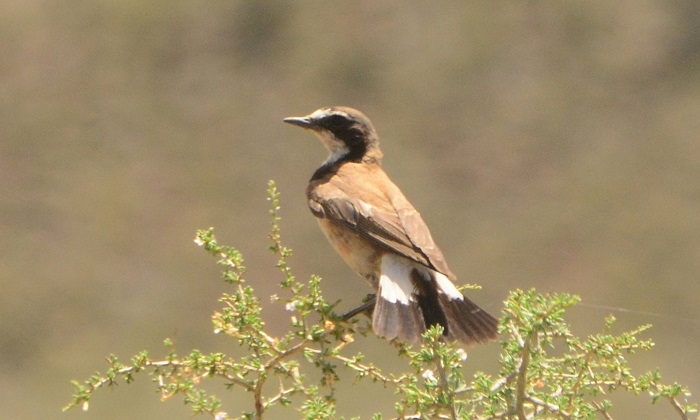Cover image of Capped Wheatear by Sybrand Venter – Near Carnarvon, Northern Cape – BirdPix No. 219360
Identification
The Capped Wheatear is a strongly marked and attractive species.
The head and facial areas are boldly patterned. The white forehead, supercilium and throat are striking and contrast strongly with the black crown, face, sides of the neck and the broad black chest-band (diagnostic).
The upperparts are warm brown grading to a richer rufous brown on the rump. The underparts are white to cream with warm buffy flanks.
The sexes are alike.

Near Vanrhynsdorp, Western Cape
Photo by Les Underhill
The Capped Wheatear is easily recognisable in flight. The combination of rich rufous rump and the black and white tail is distinctive.

Near Gouritz, Western Cape
Photo by Pamela Kleiman
Juveniles are dull brown above with whitish-buff spotting. The underparts are off-white to buff with darker brown mottling on the breast.

Near Graafwater, Western Cape
Photo by Zenobia van Dyk
Similar Species: Adults are unlikely to be mistaken for other species. Juveniles could be mistaken for those of various wheatears and chats but the diagnostic rump and tail pattern should help to alleviate confusion.
Status and Distribution
Overall the Capped Wheatear is a common species. They are resident in some areas and seasonal or erratically present in others. Their seasonal movements are not well understood but may be in response to food availability in arid areas.

Details for map interpretation can be found here.
It occurs widely in Southern and East Africa, its range only extending north of the equator in Kenya. In Southern Africa it has a wide but discontinuous distribution. The species is only absent from the eastern lowlands of KwaZulu-Natal, eSwatini (Swaziland), southern Mozambique, the Drakensberg Mountains, Lesotho and the former Transkei in the Eastern Cape. The highest reporting rates come from the Kalahari and the winter rainfall region of the Western Cape province. It is also present in good numbers throughout the Karoo.
It is likely in some areas that the Capped Wheatear has benefitted from bush clearance for agriculture. It is not considered threatened.
Habitat
The Capped Wheatear inhabits dry grassy plains with bare or overgrazed patches, short or recently burnt grass and semi-arid shrublands across the Karoo. They are often found around stock pens and fallow and recently harvested croplands. Capped Wheatears have a preference for flat terrain.

Photo by Les Underhill
Its association with fynbos is largely secondary as a result of having adapted to tilled ground and wheat croplands.
Moves into arid habitats after rains but leaves again once dry conditions return.
Behaviour

Near Albertinia, Western Cape
Photo by Johan and Estelle van Rooyen
The Capped Wheatear is a conspicuous species owing to its habit of perching boldly in the open on bushes, fence posts, rocks or termite mounds. Has a typically upright posture when perched or looking about in between foraging. Flies low between perches. Upon landing it has a habit of bobbing its head and tail up and down while bowing its body.
They are usually encountered singly or in pairs but may also be found in family groups towards the end of the breeding season.
Most foraging takes place on the ground after flying down from its perch. The Capped Wheatear prefers to search for prey on bare or recently burnt ground. Mostly consumes arthropods like insects, spiders, centipedes and millipedes. They are especially fond of ants and termites and are also known to feed on small fruits and seeds.

Near Alberton, Gauteng
Photo by Lance Robinson
Capped Wheatears are monogamous and territorial. Pairs defend their territories against conspecifics as well as from other species such as the Karoo Chat (Emarginata schlegelii).
Breeding mostly takes place during Spring and early Summer, from September to December. Capped Wheatears are dependant on rodent burrows in which to nest. The nest is placed at the end of the burrow where it widens into a chamber. The nest is sometimes located as much as 2m underground but more usually at a depth of 50 to 100cm. Nest burrows are normally located on open ground. The nest is relatively large and cup-shaped. It is composed of grass, leaves and other fine plant material and lined with hair, feathers and other soft material.
Two to four eggs, or occasionally five are laid per clutch. The eggs are pale greenish-white or bluish-white and usually lack other markings. Further details regarding incubation and the nestling or fledgling periods are unrecorded.

Carnarvon district, Northern Cape
Photo by Ryan Tippett
Further Resources
Species text adapted from the first Southern African Bird Atlas Project (SABAP1), 1997.
The use of photographs by Johan and Estelle van Rooyen, Lance Robinson, Les Underhill, Pamela Kleiman, Sybrand Venter and Zenobia van Dyk acknowledged.
Virtual Museum (BirdPix > Search VM > By Scientific or Common Name).
Paper in Biodiversity Observations on Capped Wheatears breeding in rodent burrows
Other common names: Hoëveldskaapwagter (Afrikaans); Inkotyeni, Isixaxabesha (Xhosa); Ntidi (Tswana); Traquet du Cap (French); Erdschmätzer (German); Aardtapuit (Dutch); Chasco-de-barrete (Portuguese)
Recommended citation format: Tippett RM 2023. Capped Wheatear Oenanthe pileata. Biodiversity and Development Institute. Available online at http://thebdi.org/2023/07/17/capped-wheatear-oenanthe-pileata/

Sani Road, KwaZulu-Natal
Photo by Pamela Kleiman

